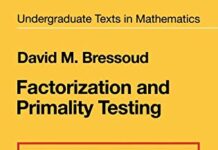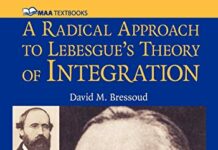
Ebook Info
- Published:
- Number of pages:
- Format: PDF
- File Size: 14.82 MB
- Authors: David M. Bressoud
Description
In the second edition of this MAA classic, exploration continues to be an essential component. More than 60 new exercises have been added, and the chapters on infinite summations, differentiability and continuity, and convergence of infinite series have been reorganized to make it easier to identify the key ideas. A Radical Approach to Real Analysis is an introduction to real analysis, rooted in and informed by the historical issues that shaped its development. It can be used as a textbook, or as a resource for the instructor who prefers to teach a traditional course, or as a resource for the student who has been through a traditional course yet still does not understand what real analysis is about and why it was created.
User’s Reviews
Reviews from Amazon users which were colected at the time this book was published on the website:
⭐A Radical Approach to Real Analysis is really a historical approach to real analysis. Like the author’s book on Lebesgue integration the author attempts to motivate the subject of real analysis by going through the history of what mathematicians were looking to solve and what motivated the formalism of real function theory. The book I believe should be used more as an accompaniment for a real analysis class rather than as a primary text, but as an accompaniment it can be quite beneficial in adding motivation.Real Analysis is one of the first very challenging university math classes one can take, similar to a first course in abstract algebra. It is a formal subject where axioms are the foundation of proofs and the subject can be very dry after being used to solving computational problems in calculus. Nonetheless it is taught this way because it is the only real way to learn how formal math is really approached. The author views this as disappointing to some extent as the original pioneers in real function theory did not do real analysis as it is done today. The author starts out by describing a problem in Fourier analysis and questions of convergence. The author then starts to motivate all topics in real function theory through convergence and what it means and how mathematicians thought about it. Famous counterexample to intuitive concepts are introduced to discuss how mathematicians were forced to analyze the properties of completeness of the real numbers and what convergence meant for series. The problems are a mixture of proofs and computation, there are also hints at the back so that one can self-study from this text quite easily. Fourier convergence is a core area which motivated the subject so the author includes many examples from this rich subject to motivate real function theory (similar to his book on Lebesgue theory). The topics are quite typical in discussing series and sequences of real numbers, then sequence and series of functions, differentiation and Riemann integration are discussed towards the end.I think this is a good book but it is not radical as the title implies. It is a real analysis textbook motivated by historical problems. This is useful for pedagogy and is often missing in real analysis books. That being said I think as a first real analysis textbook Abbot remains the best, most intuitive and one does not need this as a complementary book if one studies from that. If one only had a dry textbook to first learn from this could be very useful.
⭐I am a topologist by training who was Shanghaied into being an analyst when I was hired as a teacher. As a consequence of this, the Advanced Calculus course I taught was rather heavy on topology.Over the course of time–having been transformed into more of an analyst that I would have ever dreamed–I’ve come to the conclusion that analysis is best learned before topology.This is a text that accomplishes that by using the historical approach.One learns how Newton approached problems, how Euler did, how Cauchy did. Not only is it interesting, it is enlightening. I’ve taught this course for 15 years now, and of all of the approaches I’ve taken, this has been the most fruitful.My students have come from calculational courses, and the historical approach of this book provides a bridge over which they may come into the land of proof. They also see the issues that caused the need for modern rigor face to faceI do supplement the course with material that is more modern (Hardy’s book A Course of Pure Mathematics) and material on the Riemann integral, but I’ve been spoiled for any other approach.
⭐This book is skillfully written by someone who has studied the history of calculus carefully and who also cares deeply about good instructional practice for undergraduate mathematics education. I have not yet used this book in teaching a course at the university where I am employed as a full-time math professor. However, I am looking forward to the next opportunity. It just makes sense to teach a complicated subject like Real Analysis in a manner that follows the historical development because that is likely to be a route that seems the most natural for a large number of students.
⭐If you had calculus in high school or college then you learned about Newton, Leibnitz, and Riemann but probably did not encounter Lebesgue (pronounced le-bek). At the University of Alabama Huntsville learning about Lebesgue integration is key to advancing into graduate studies in mathematics. The natural follow-on course after Calculus I and II, etc. is Real Analysis. This book, using Lebesgue integration methods, is a good sequel to Lebesgue calculus.I purchased this book, after reading about it in the Mathematical Association of America (MAA). For autodidacts like myself, it is a good first introduction to the topic.
⭐Very much enjoyed this treatment. Real analysis has always been a challenge for me, but I could make some headway with this book
⭐The book was in really great condition and the postage was punctual.Despite it being a bit pricey I thought it was a good buy.
⭐There is such a dramatic change between the volumes that you cannot get away from buying the newest edition. If you need this book, do not buy this one unless specifically told to get the 1st edition or paperback version.
⭐Used this to teach an undergrad course. Love how the author follows the historical development of analysis. This helped keep students interested in the course.
⭐I bought the book because I had a keen interest on understanding the very particular historical point of view of Bressoud’s style.I find it a very interesting introduction to real analysis, that differs pretty much from other books on the same topics.Although the book lacks more advanced topics, those who are very familiar with analysis and calculus will also benefit from it, and definitely give a new perception of the field. I would recommend it particularly for undergraduate teachers, as its pragmatic approach tends to create a sort of attraction for the topics examined.Proofs are very clearly described, and I could also find some different approaches that revealed to be more intuitive than the most traditional ones.
Keywords
Free Download A Radical Approach to Real Analysis (Mathematical Association of America Textbooks) 2nd Edition in PDF format
A Radical Approach to Real Analysis (Mathematical Association of America Textbooks) 2nd Edition PDF Free Download
Download A Radical Approach to Real Analysis (Mathematical Association of America Textbooks) 2nd Edition PDF Free
A Radical Approach to Real Analysis (Mathematical Association of America Textbooks) 2nd Edition PDF Free Download
Download A Radical Approach to Real Analysis (Mathematical Association of America Textbooks) 2nd Edition PDF
Free Download Ebook A Radical Approach to Real Analysis (Mathematical Association of America Textbooks) 2nd Edition


